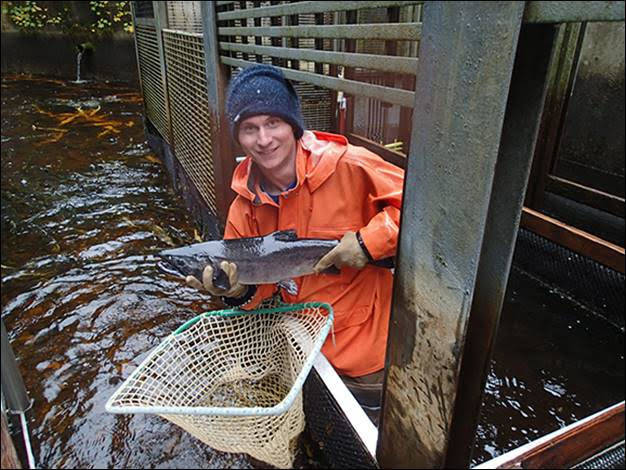The hatchery at Auke Creek is small, but it allows researchers to look into some big ideas.
Auke Creek is the outflow from Auke Lake. It’s about 400 feet long and the site of a weir and experimental hatchery that creates a singular research opportunity.
“Auke Creek really is a unique source of information,” said David Tallmon, professor of biology for University of Alaska Southeast, during a Friday night presentation. “There is the highest quality of data, I would argue, for Pacific salmon anywhere in the range of Pacific salmon. In terms of inferences about wild salmon, it’s really a unique situation.”
Scott Vulstek, Alaska regional fishing coordinator for National Oceanic and Atmospheric Administration (NOAA); Megan McPhee, associate professor of fisheries for University of Alaska Fairbanks; and Tallmon said during a Fireside Lecture at Mendenhall Glacier Visitor Center that the size and location of the facilities are well suited for keeping close tabs on a variety of fish species.
“At Auke Creek, one of the great things is we count every fish,” Vulstek said. “It’s not so big that you can’t reasonably count every fish, but it’s large enough that you can do some experiments and answer some really interesting questions.”
[A look into Mendenhall’s future]
Several types of fish move through the creek during the year, including pink, sockeye and coho salmon. Cutthroat and Dolly Varden trout are also common, Vulstek said.
“We are one of the only consistent sources of information on these guys as far as their abundance coming and going in Juneau,” Vulstek said of the trout.
Counts taken the last couple of years have been “a bit concerning,” Vulstek said.
A normal return of pink salmon for an even year at Auke Creek would be about 8,000. Last year, there were fewer than 400.
“That was true throughout Southeast, maybe not quite to this extent in every system, but it was down quite a bit,” Vulstek said.
Tallmon said data from the weir has led to the observation that salmon runs are occurring earlier and happening over a shorter period of time.
The same scope that makes it possible to count the fish also makes it possible to genetically sample adult sockeye salmon for a study being conducted by UAF, NOAA and the Alaska Department of Fish and Game, McPhee said. Vulstek said samples are taken via a fin clip.
“Information about the relative fitness of hatchery and wild salmon is important for understanding the consequences of hatchery programs,” McPhee said. “Auke Creek is an ideal place for conducting these kind of studies.”
By taking the samples, researchers are able to compare fish genomes and determine the parentage of salmon. This helps increase the understanding of interactions between hatchery-born and wild-born salmon, McPhee said, but there are not yet results ready to share.
“The study is not really anywhere near complete,” McPhee said.
Additionally, the weir is allowing for research into taking DNA from water where there were fish to determine how many and what kind of fish swim by. Tallmon referred to the samples of environmental DNA taken as e-DNA and said there aren’t many good settings to test whether DNA taken from water is yielding accurate information.
“That’s where Auke Creek comes in,” Tallmon said. “Because we have counts of fish passing the weir each day, we can collect samples behind those fish and see whether we’re correctly determining the number of fish that are upstream based on concentration or counts of DNA from each species that are moving past.”
[Moving suicide and mental illness into a public forum]
Early results of a study using the technique at the weir have been fairly encouraging.
“The upshot is at least kind of exciting,” Tallmon said. “It seems like you might be able to use this approach on a large scale much more cheaply than you could deploy hundreds of undergraduates across Southeast Alaska to work at a weir.”
In addition to generating information, Tallmon said the weir generates revenue for Juneau in an indirect way.
“Having this weir allows us to apply and be competitive for research grants we otherwise wouldn’t get, and by getting those research grants we’re able to bring in money that we can use to pay salaries, to buy equipment to buy supplies that goes into our local economy,” Tallmon said. “It is a small engine in a larger machine that does contribute locally economically in real ways.”
• Contact arts and culture reporter Ben Hohenstatt at (907)523-2243 or bhohenstatt@juneauempire.com. Follow him on Twitter at @BenHohenstatt.

